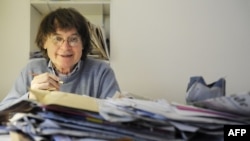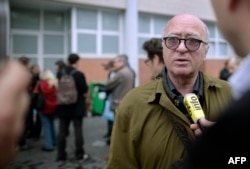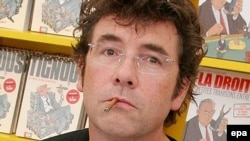Four of France's most revered cartoonists were among the 12 people killed when gunmen stormed the office of Charlie Hebdo.
The killings have shocked France, where a whole generation grew up with their drawings.
Jean Cabut, known as Cabu, 76
Cabu, known for his trademark round glasses and bob haircut, was a leading figure at Charlie Hebdo.
He published his drawings in a range of French newspapers, including Le Monde, Le Figaro, and France's other cult satirical weekly, Le Canard Enchaine.
He joined Charlie Hebdo's predecessor, the now-defunct Hara-Kiri newspaper, in the 1960s, where he met Wolinski and other famous cartoonists such as Gebe and Reiser.
His most famous creations are the Grand Duduche, a clumsy and rebellious teenager, and the Beauf, a caricature of French racists and chauvinists.
In the 1970s and 1980s he took part in a widely popular children's television program Recre A2, in which he drew sketches live.
He was the father of singer Mano Solo, who died in 2010.
Cabu once said that the one thing he wished to be remembered for was drawing with an old-fashioned quill pen.
Georges Wolinski, known as Wolinski, 80
Born in Tunisia from a Polish and an Italian mother, Wolinski was also a pillar of the French cartoon scene.
He started drawing well before Charlie Hebdo was launched in 1970 following the closure of Hara-Kiri by French authorities.
Wolinski's drawing appeared in a number of French leftist newspapers and magazines. He was awarded the Legion d'Honneur, France's highest distinction, in 2005.
"Cabu and I are not provocateurs. We are not looking for trouble," he once said. "We just want to make good, funny drawings that make people laugh. Sometimes we go a little too far, but people like that."
Stephane Charbonnier, known as Charb, 47
Charb took the helm as editor of Charlie Hebdo in 2009 after working at the weekly for more than 15 years.
His most enduring characters are the anarchist dog Maurice and the fascist cat Patapon.
He had been living under police protection after receiving death threats for Charlie Hebdo's publication of a cartoon of the Prophet Muhammad in 2011.
The newspaper was firebombed and its website hacked over the drawing.
One of his lasts cartoons depicted an Islamist terrorist saying "Still no terror attack in France. Wait! We still have until the end of January to deliver our wishes."
Bernard Verlhac, know as Tignous, 47
Tignous, known for his simple but caustic caricatures, had been a popular cartoonist for the French press since the 1980s.
He contributed to Charlie Hebdo as well as to a several other leading newspapers and magazines such as L'Express, Le Monde, or Marianne.
He also drew for the comic-strip magazine Fluide Glacial.





